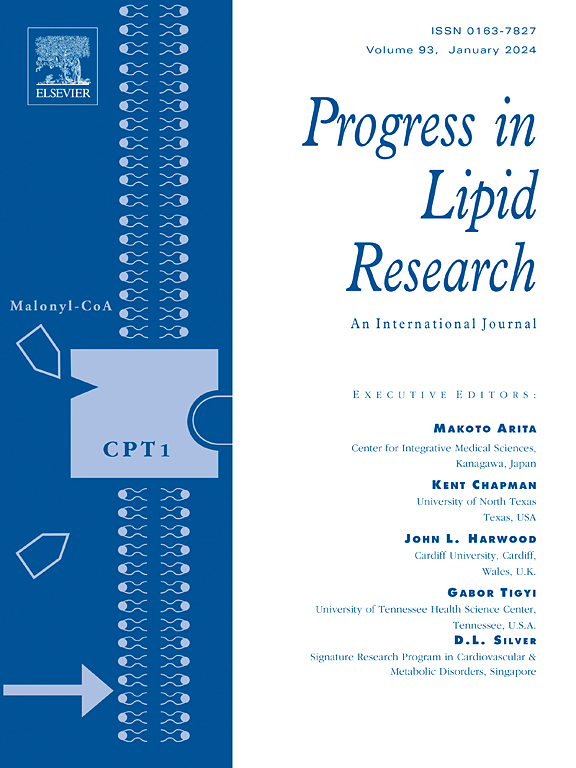The balancing act between lipid droplets and lysosomes for membrane functionality in age-related neurodegeneration and inflammation
IF 14.9
1区 医学
Q1 BIOCHEMISTRY & MOLECULAR BIOLOGY
引用次数: 0
Abstract
Age-related neurodegenerative disorders are often associated with disruptions in lipid metabolism. A critical aspect is the impairment of the interaction between lipid droplets (LDs) and lysosomal function, leading to the accumulation of toxic lipid species. This accumulation triggers cellular stress, inflammation, and defective waste processing within cells, disrupting cellular homeostasis and amplifying neuroinflammatory processes. Recent studies have shown that alterations in phospholipid and fatty acid homeostasis drive neuroinflammation and oxidative stress, exacerbating neurodegenerative processes. This review focuses on the role of neuropathy target esterase (PNPLA6/NTE) and NTE-related esterase (PNPLA7/NRE) in lipid metabolism, highlighting how dysregulation of these enzymes contributes to neurodegeneration, inflammation, and lysosomal dysfunction. Additionally, we discuss the involvement of lipid rafts, sphingolipids, and phospholipase enzymes, particularly PLA2 family members, in cellular signaling and membrane dynamics. By examining the relationship between lipid metabolism, inflammatory signaling, and lysosomal storage disorders, we aim to provide a comprehensive understanding of how LDs and lysosomes interact to influence cellular homeostasis in neurodegenerative conditions, which could lead to new therapeutic strategies addressing lipid dysregulation in age-related neurological disorders.
脂滴和溶酶体在年龄相关性神经变性和炎症中膜功能的平衡作用
年龄相关性神经退行性疾病通常与脂质代谢紊乱有关。一个关键的方面是脂滴(ld)和溶酶体功能之间相互作用的损害,导致有毒脂质的积累。这种积累引发细胞应激、炎症和细胞内有缺陷的废物处理,破坏细胞稳态并放大神经炎症过程。最近的研究表明,磷脂和脂肪酸稳态的改变驱动神经炎症和氧化应激,加剧神经退行性过程。本文综述了神经病变靶酯酶(PNPLA6/NTE)和NTE相关酯酶(PNPLA7/NRE)在脂质代谢中的作用,强调了这些酶的失调如何导致神经变性、炎症和溶酶体功能障碍。此外,我们还讨论了脂筏、鞘脂和磷脂酶,特别是PLA2家族成员,在细胞信号传导和膜动力学中的作用。通过研究脂质代谢、炎症信号和溶酶体储存障碍之间的关系,我们旨在全面了解ld和溶酶体如何相互作用影响神经退行性疾病的细胞稳态,这可能会导致解决年龄相关神经疾病中脂质失调的新治疗策略。
本文章由计算机程序翻译,如有差异,请以英文原文为准。
求助全文
约1分钟内获得全文
求助全文
来源期刊

Progress in lipid research
生物-生化与分子生物学
CiteScore
24.50
自引率
2.20%
发文量
37
审稿时长
14.6 weeks
期刊介绍:
The significance of lipids as a fundamental category of biological compounds has been widely acknowledged. The utilization of our understanding in the fields of biochemistry, chemistry, and physiology of lipids has continued to grow in biotechnology, the fats and oils industry, and medicine. Moreover, new aspects such as lipid biophysics, particularly related to membranes and lipoproteins, as well as basic research and applications of liposomes, have emerged. To keep up with these advancements, there is a need for a journal that can evaluate recent progress in specific areas and provide a historical perspective on current research. Progress in Lipid Research serves this purpose.
 求助内容:
求助内容: 应助结果提醒方式:
应助结果提醒方式:


